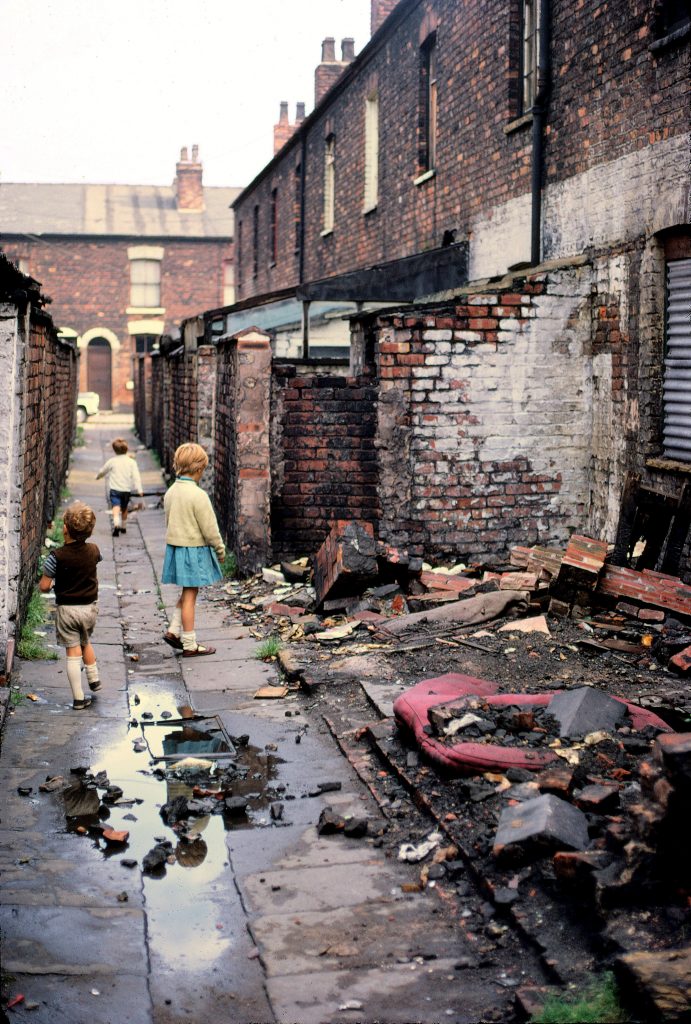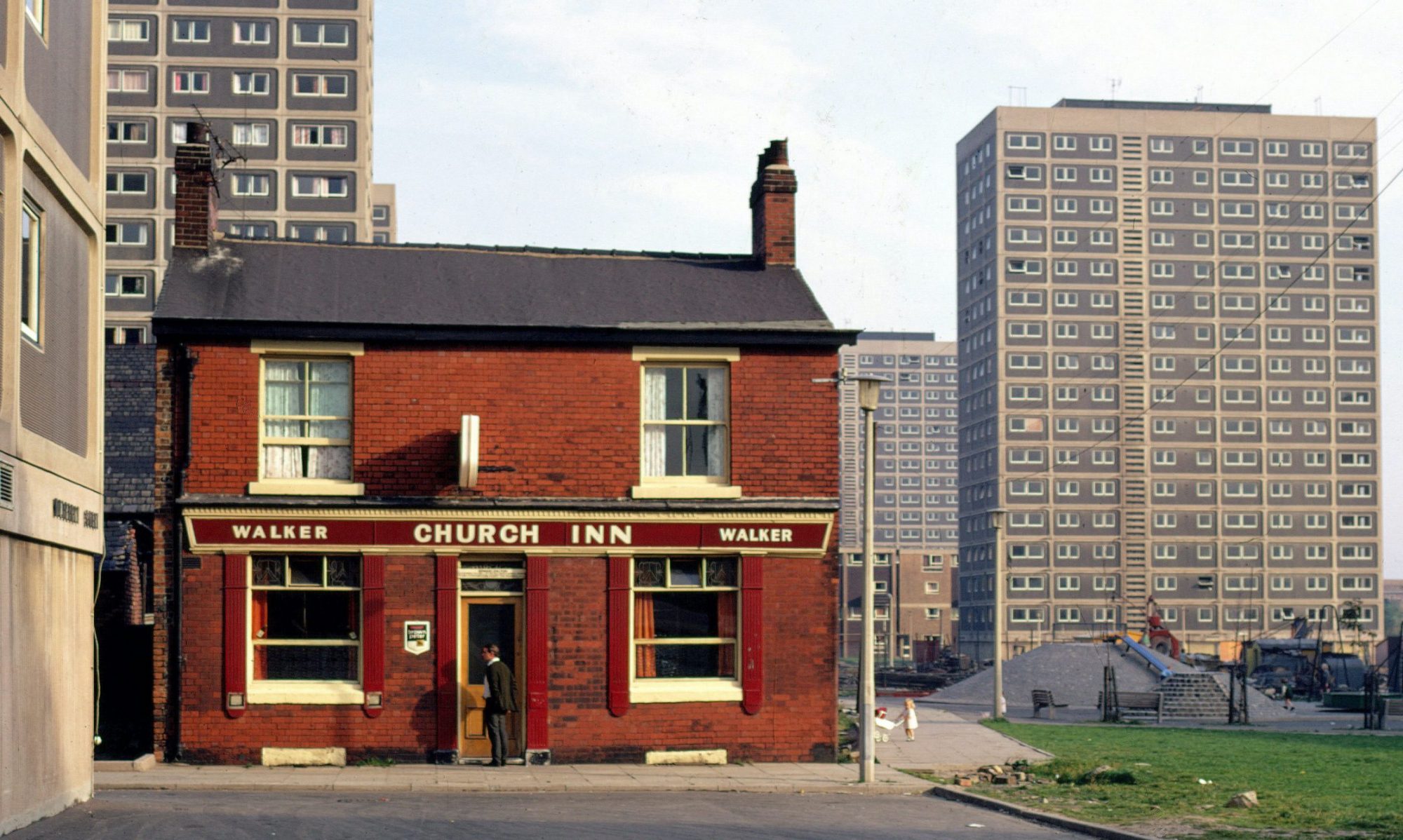Growing Up in Sixties Salford
by Brian M Clarke
Part II of Brian Clarke’s unpublished book Haunted Memories is about his recollections on the rapid changes unfolding in Salford during the 1960s. While Part 1 was describing the excitement, concern and wonder of a young boy about moving house – who wouldn’t have like a zoo in their basement at that age? – now, the slightly older boy finds himself amidst prefabricated modern schools and estates and – more importantly – within a demolition site that became a playground full of possibilities of exploration and adventure.
Another sign of Salford’s rapid progress was the return of prefabricated buildings – but this time to build high rise flats to house people from the ‘redevelopments’. Using these factory-made walls, floors and ceilings, an entire storey of a flat could be erected within a week. The scale and speed of their rising was daunting. The redevelopment of nearby Broad Street was also underway where dozens of small shops were to be replaced with spacious shopping and market areas in a new traffic free shopping precinct.
One of the most exciting aspects of all this redevelopment was the pulling down of houses and the building of new ones. As kids we weren’t all that interested in the new ones but the old houses, in their various states of demolition, were magnets for kids from miles around. The acres of empty and semi-demolished houses scattered around us in increasing numbers became our adventure playgrounds. Former homes were emptied of belongings and left to the inquisitive eyes and adventurous hands of people like me; grubby little urchins looking for something to amuse or fascinate. Or destroy.
We were attracted to these skeleton homes for a variety of reasons. Firstly, there was the sense of discovery and exploration. Who knew what you would find in these disheveled and deserted wrecks? People had left with only the things they wanted, often leaving behind unfathomable kiddie treasures. Abandoned washing mangles were fascinating to take apart or simply smash to bits. As were broken televisions, cupboards and anything else left around. Each house was an Aladdin’s Cave if your idea of treasure was junk.
Secondly was the sense of danger present with every loose brick, dangerous pipe, smashed window or broken floorboard. As these houses fell into various stages of dilapidation, they presented young explorers with a host of manly challenges. The most exciting one of all – and made even more exciting by its express forbidding by parents – was climbing. These houses often had gable ends with an outcrop of house bricks, holes and easy-to-reach window ledges and roofs that proved irresistible to the army of tiny explorers investigating the thousands of instant Adventurelands only minutes from our doors.
Thirdly was the way that going in an old house or scrabbling over waste ground brought every sense alive. The ordinary world was, well, ordinary – but going into a house and crawling through a hole in the wall to the adjacent house made you alive in ways that you were not used to. Your senses reached out to delight in the new smells, strange textures and eerie sounds that every encounter brought. Sometimes – like when we had gone to the demolished theatre – the adventure brought you into contact with kids from different streets doing the same as you. Most often we ignored each other – especially if our gangs (usually three) were of the same size and ages. If there were more of them than you or if they were a few years older, then retreat was the better part of valour.
These mysterious ruins were constantly being enhanced by junior engineers who smashed holes between walls in terrace houses to link entire rows together, or installed swing ropes to get across holes on the floorboards or even built makeshift lookouts on the roof to provide an unseen view of our streets. As we went from house to house there was a constant set of challenges to test your courage and berate anyone who fell short of the trial. If one of us climbed an unsteady wall to reach the top, then the others had to do it or lose face. If one of us crawled into a pitch-dark tunnel, then the others had to follow suit. Back out too often or fail to display your courage and your suitability to be a pioneer was questioned and you might not be invited on future explorations.

Climbing over hazardous buildings and into dangerous spaces wasn’t as safe as it sounds. Bricks could easily come lose as you ascended, one toe and hand hold at a time, up the edge of an abandoned house. And the getting up was the easy part. Sometimes you reached the top only to realised that the coming up route was not the going down route. You would be stranded at the top of a wall or on the edge of a roof, desperately looking for a safe way down. Quite often there was no ‘safe way’ down, just a couple of less dangerous options. Jumping to a lower landing spot was always the favourite but that could contain hidden dangers. A friend from St Joseph’s called Robert was with us when we found ourselves compromised on the roof of an empty office building. It wasn’t very high but after getting up we couldn’t see a way down. Another friend pointed to a shed a few feet below us and the leap to the roof seemed doable. My friend leapt first and landed on the edge of the shed, steadied himself and flashed one of those ‘I dare you’ smiles for us to copy his daredevil feat. Not seeing an alternative and having just seen him land safely on the shed roof I adopted the classic pre-jump crouch, picked my landing spot, checked the distance several times and leapt into free space. Like him, I landed on the edge of the shed and rolled to absorb the impact. We turned to look at Robert who needed our rowdy encouragement to make the leap.
We had made sure to land on the edge of the shed where it was reinforced with the wall, knowing that his would be the strongest part. We didn’t say that out loud; it was just something that urban climbers like ourselves knew. It had its own danger if you fell short but overall it was the safest thing to do. Robert, however, had other ideas. Instead of landing on the edge and risk slipping backwards into the yard and the rubble below, he extended his leap so that he hit the roof nearer its middle rather than the walled edge. The target was bigger and the chance of falling off was minimal. He took his leap – and disappeared through the weak corrugated roof into the shed.
Calls for help mixed with cries of pain and when we were able to peer through the hole, we saw Robert sprawled below. He had cut his leg and ripped his jeans. The ripped jeans were the more important matter because as Robert repeated mantra-like, he would get ‘battered’ by his mam when he got home. The cut wasn’t too bad and Robert was able to limp through the shed door and climb over the gate to get out. We hung on to the edge of the shed and dropped to the pavement. The three of us were safe but only two of us looked forward to going home.
Daily adventures like this built comradeship and told you who you could trust if you found yourself in a tight corner. These networks of ‘mates’ would prove useful as we became teenagers and the range of our activities increased.
Copyright Brian M Clarke. All rights reserved.



A fascinating and really well written account. The comment “Climbing over hazardous buildings and into dangerous spaces wasn’t as safe as it sounds” made me smile.